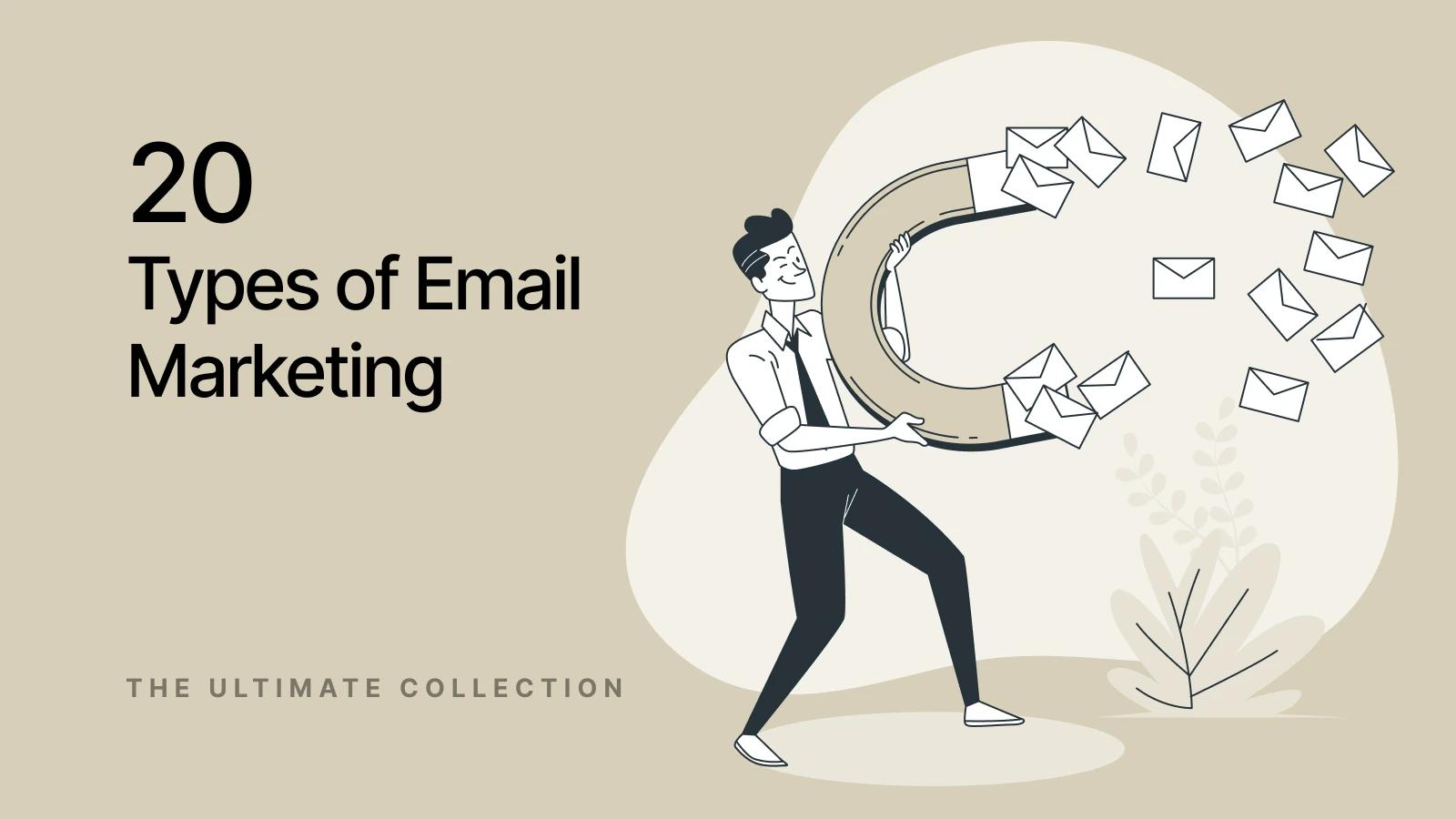Ever taken a moment to think about the sheer magic of emails? Yep, amidst the wild flow of Insta stories, TikToks, and endless tweets, good old email is still rocking the digital stage. 📩
With over 4.03 billion users globally, email is basically that friend we all underestimate but secretly can't live without. And here's a fun insight: for every dollar spent on email marketing, there's a jaw-dropping return of $42.
Crazy, right? But the real question is, how do you get a slice of that pie?
Emails are not just about "send and forget". It's like having coffee with someone. You wouldn’t just blurt out everything and leave, would you
Creating comprehensive customer profiles is vital for targeted marketing. Reverse email lookup tools enable marketers to gather a wealth of information, helping them to build more accurate and detailed profiles. This data can include demographic information, interests, and online behavior, all of which are valuable for crafting personalized marketing strategies.
It's a two-way street: you talk, they listen; they talk, you listen. And sometimes, if the coffee’s really good (or the email content, in our case), the conversation lasts longer and gets super interesting!
Most Common Types of Email Marketing 📧
Whether you're just starting out or you’ve been in the email game for a while, there are so many cool ways to benefit from email marketing. You just need to use it wisely.
There is so much stuff out there: we’re talking welcome notes that feel like high-fives, educational tidbits that are as fun as trivia night, and so much more.
So, grab your digital pen and let’s go through the best types of email marketing together.
1. Promotional Emails
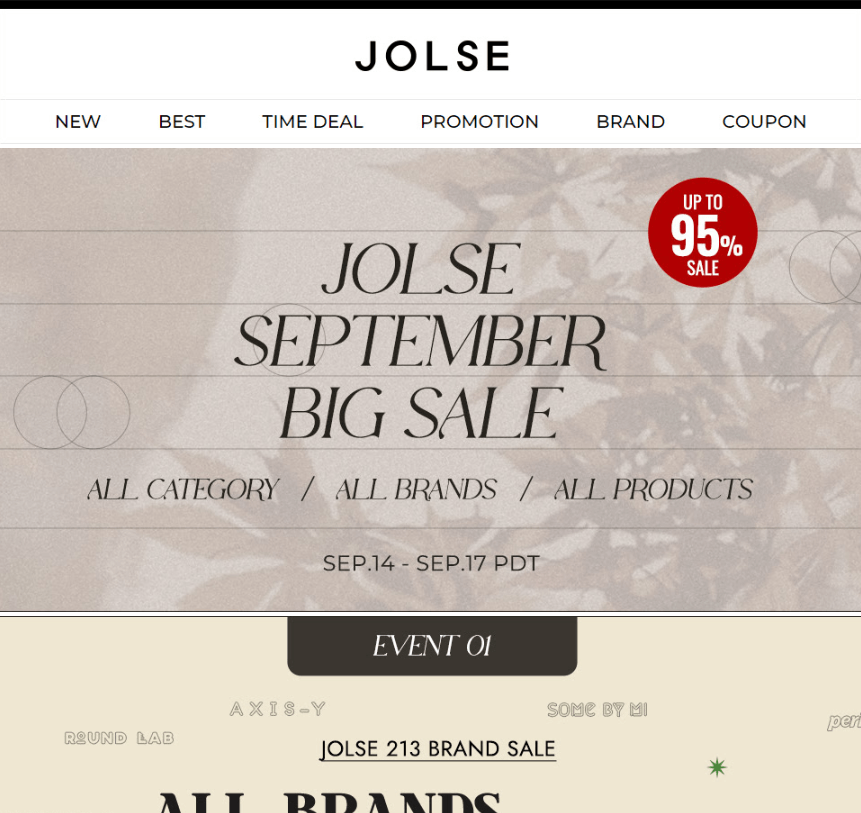
Jolse
Ever received that email announcing a jaw-dropping sale on your favorite store and thought, "Well, looks like the universe really wants me to treat myself today!"? That's the power of promotional emails.
Promotional emails are those shiny announcements delivered right to your inbox, usually sharing best deals, limited-time offers, or showing new products that might just become your client's next obsession.
But why do they work?
Think about it. Who doesn't love feeling special? With a well-crafted promotional email, brands whisper sweet nothings into our ears (or, well, eyes), making us feel like we've just been handed an exclusive golden ticket.
Being one of the most popular types of email marketing, promotional emails should stand out to grab the attention.
Here are some tips on how to shape those emails:
- Subject Line: First impressions matter. Think of your subject line as the sassy introduction to a fabulous story. "Guess what's 50% off?" or "Psst... Exclusive deal just for you!" might just have your readers leaning in with interest. Make it catchy, a little mysterious, even.
- Personalize, Don’t Generalize: Ever noticed how being called by your name feels so much cozier? Personalization goes beyond that! Use data smartly to tailor content based on past purchases, browsing history, or location.
- Visual Vibes: Humans are visual creatures. Engage them with crisp images, punchy GIFs, or even a short video. Showcase your products in action, or create an aesthetic that's unmistakably YOU.
- Keep It Short & Snazzy: Let's be real, nobody has the time to read 'War and Peace' in an email. Get to the point, sprinkle in some wit, and wrap it up. It's like a mini roller-coaster of excitement.
- Clear Call-to-Action (CTA): "Shop Now!" "Grab Your Deal!" "Join the Party!" Your CTA is the climax of your story. Make it big, bold, and impossible to resist. It's the "drop the mic" moment of your email.
2. Newsletter Emails

Binance
These are regular updates sent by companies, individuals, or organizations, spilling the beans on the latest news, content, offers, or any juicy tidbits they think their audience would devour.
These types of marketing emails are like that weekly catch-up over coffee with a friend. It reminds your audience you exist and you care.
If done right, these aren't just emails. They're packages of value, giving knowledge, insights, or simply a reason to smile. You stay connected with your audience.
Newsletters give off those warm, fuzzy community vibes. It's like gathering around a campfire and sharing stories. Your readers appreciate your input into communication.
Want to master the newsletter game? Here's how:
- Consistency is Key: Decide on a frequency – weekly, bi-weekly, monthly. But once you pick, stick to it like glitter on glue!
- Mix it Up: A blend of content keeps things fresh. Think updates, user-generated content, spotlight stories, and the occasional dad joke (because why not?)
- Be Authentically You: No one likes a robot (unless it's Wall-E!). Let your unique voice shine. Be it quirky, professional, or downright hilarious. Authenticity connects.
- Know Your Audience: Tailor content to your reader's tastes. If they're tech geeks, a piece on "The Future of AI" might tickle their fancy. If they're home chefs, perhaps "Top 10 Spices Every Kitchen Needs."
- Clear CTA: Whether it's "Read More," "Join the Event," or "Share Your Thoughts," make sure there's a clear action you'd love your readers to take.
- Feedback Loop: Encourage feedback. Maybe end with, "Got a topic you're burning to learn about? Hit reply!"
There are best email marketing services that can guide you in shaping your perfect email strategy.
3. Lead Nurturing Emails
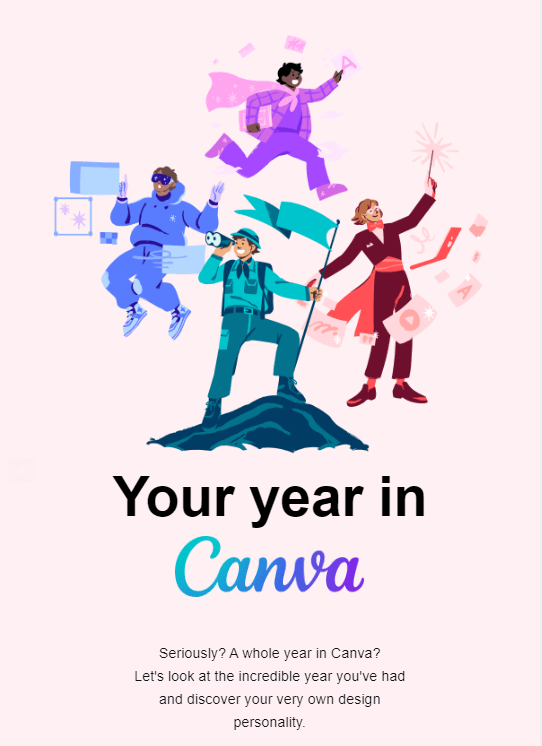
Canva
Imagine meeting someone new at a party. Now, you wouldn't just blurt out, "Hey, want to be besties and go on a road trip together?" That might be a tad... forward. Instead, you'd probably chat, share stories, maybe bond over something.
That process of getting to know each other, building trust, and forming a connection? That’s what lead nurturing emails do for your business.
They're a series of emails sent out over time to warm up potential customers, guiding them gently down the sales funnel.
But how to make them work?
- Segment, Segment, Segment: Not all leads are created equal. Segmenting makes sure you're sending the right message to the right person at the right time.
- Provide Value: This can't be stressed enough. Whether it's an insightful article, a handy guide, or an exclusive webinar – offer them something they can't refuse.
- Engage: Ask questions, invite feedback, or start a conversation. Make your email a two-way street.
- Test & Tweak: Test different approaches – subject lines, content types, sending times. See what resonates and respond accordingly.
Find out how to generate leads from blogs.
4. Survey Emails

Skrill
These types of email marketing are a way to gather feedback, opinions, or understand the preferences of your audience. It’s like sending out a digital comment card. And, oh boy, are they valuable! Instead of guessing what your audience wants, you get straight insights.
Let's be honest, we all have opinions, and most of us don't shy away from sharing them. A survey is an invitation to voice those thoughts!
When your audience feels their opinion matters, they feel valued and empowered.
With the right tools and design, taking a survey can be as easy as a few clicks. No heavy lifting required.
How to make these types of marketing emails click:
- Keep It Short and Sweet: Time is precious! Respect it by ensuring your survey isn’t as lengthy as a Tolstoy novel.
- Incentivize: Consider offering a little something as a thank you. Maybe a discount, a freebie, or even a sneak peek into upcoming goodies.
- Transparent Purpose: Let people know why you're asking. Are you making product improvements? Planning events? Curious about new features they'd like? Clarity is key here.
- Engaging Design: Ditch the dull. An appealing, interactive design can make the difference between a completed survey and one that’s abandoned mid-way.
5. Milestone Emails
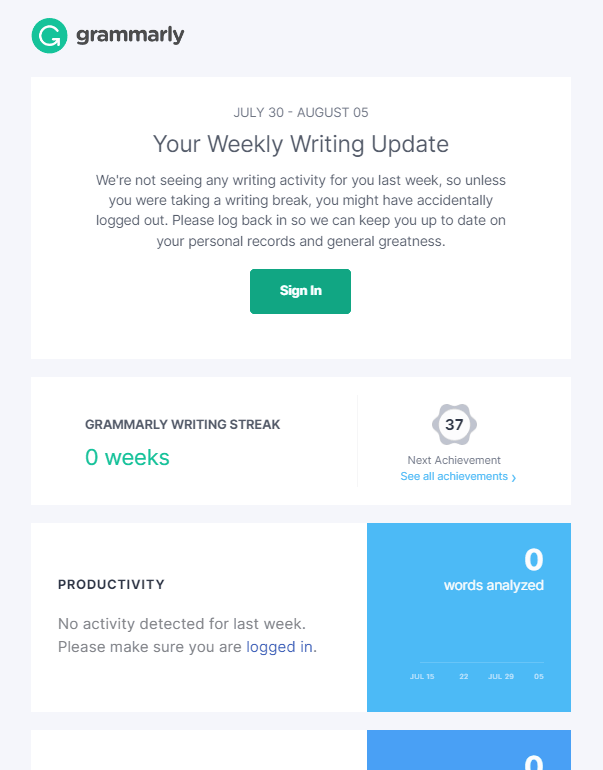
Grammarly
Imagine a heartwarming message from your favorite online store, celebrating your one-year anniversary since your first purchase. And, as a cherry on top, they've thrown in a special discount just for you. Ah, the feels! Friends, you've just been serenaded by a Milestone Email.
These emails celebrate significant moments in the customer’s journey with a brand. Adding a custom QR code to your milestone email allows you to offer a digital discount or a special surprise. It's an engaging way for customers to interact with your brand while reinforcing the celebratory nature of the email. Whether it's an anniversary, a certain number of purchases, or even a birthday, milestone emails are there, waving tiny digital flags and throwing confetti.
There's something profoundly emotional about remembering. Milestone emails not only recall good memories but strengthen the bond between a brand and a customer.
Keep in mind when crafting such types of email marketing:
- Authenticity is Key: A genuine "thank you" or "congratulations" can go a long way. So skip the generic and give genuine appreciation.
- Sprinkle Some Gifts: A little token, maybe a discount or a free product sample, leaves a stronger effect than you think.
- Dazzle with Design: Celebrations are vibrant, and so should be your email. Think colorful banners, fun animations, and cheerful typography.
6. Welcome Emails
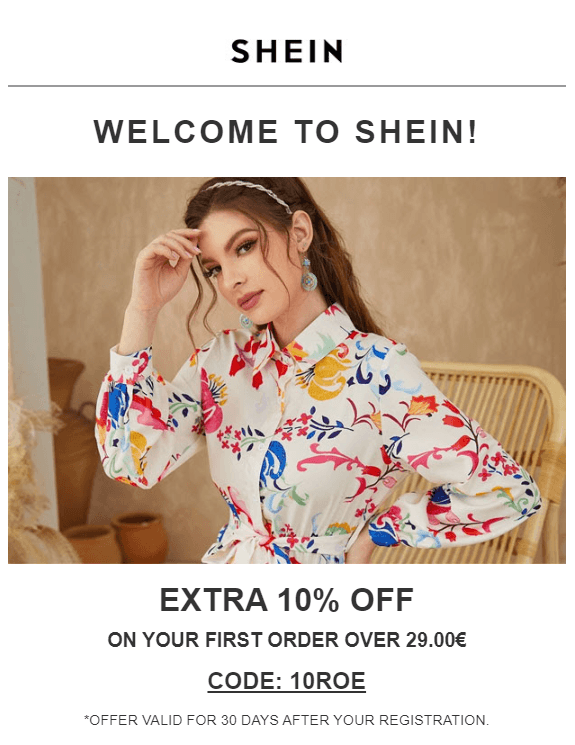
Shein
Those are your virtual open arms. They’re the first official communication a subscriber receives after joining your mailing list, making a purchase, or signing up for your services.
Think of them as the friendly barista who knows just how you like your coffee on your first visit to a new café—warm, comforting, and a promise of great things to come.
First impressions matter. And boy, do welcome emails make a good one! They set the tone for your brand relationship. If your first email is a warm, welcoming beacon, imagine the loyalty and trust you're building.
How do you make these types of email marketing work?
- Make it Personal: Everyone likes to be acknowledged. Use their name, reference something they did (like a purchase or sign-up), and make them feel seen.
- Clear Call to Action: Gently guide your new subscriber to the next step. Whether it's checking out a new collection, joining a community, or just browsing around.
- Offer a Warm Gesture: Maybe a little discount? A fun downloadable? It's a nice gesture that can build a beautiful relationship.
Statistically, welcome emails are one of the most opened types of emails. They're your spotlight moment, so shine bright!
7. Dedicated Emails
It’s about one topic, one product, one event, or one message, and it demands your attention. Think of the last time you got an invitation to an exclusive sale or a special webinar—that, my friend, was likely a Dedicated Email.
Ever heard the phrase, "Jack of all trades, master of none"? In the noisy world of inboxes, an email trying to say too many things can easily be ignored. A Dedicated Email, however, has clarity in its message.
Because these emails are so laser-focused, readers tend to engage better. They know exactly what's expected of them—no confusion, no sidetracks.
Making your dedicated emails shine:
- Bold and Clear CTAs: When you have one message, make your Call to Action (CTA) unmistakable. Big. Bold. Beautiful. Maybe even with a hint of sparkle.
- Aesthetics Matter: Since it's all about one message, your visuals need to support that message. Invest in good visuals.
- Keep it Brief: Remember, you're putting one message in the spotlight. Keep your content concise, letting the reader quickly take action.
8. Re-Engagement Emails
These types of email marketing have a special spirit. A friendly one. It's an emotional nudge, a gentle tap on the shoulder saying, "Hey, remember us?"
Humans are creatures of emotion. So it's important to remind subscribers of the good times and the value you once added to their lives. It's about rekindling that warmth.
Data cleaning is another practical reason to use these types of email marketing campaigns. These emails help identify inactive subscribers. If they don’t engage even after this, maybe it’s time to let them go (with a tear or two).
Perhaps the subscriber drifted away for a reason. This is your chance to learn, grow, and adapt. Maybe they'll tell you what tune they’d like to dance to next.
Here are some tips:
- Personal Touch: Use their first name, remind them of what they loved (was it a product? A blog post?)/
- Special Offers: A little "Welcome Back" discount or a gift can work wonders.
- Clear Path to Re-Engage: Maybe they just need to update their email preferences. Give them an easy way to do that.
Use email marketing guide for extra help.
9. Abandoned Cart Emails 🛒

iHerb
We've all been there, right? Browsing through an online store, adding items to our cart, and then, for some reason or another—maybe a distraction, or maybe just deciding to "think about it"—we abandon our cart.
Let's face it; life gets busy. Sometimes we genuinely forget about our carts. A well-timed email can serve as the perfect reminder.
Maybe the shopper was on the fence about their decision. Your email might provide that little push, especially if there's an incentive thrown in!
Things to remember when crafting these types of email campaigns:
- Vivid Imagery: A picture is worth a thousand words. Show them what they're missing out on by including pictures of the products left behind.
- A Dash of Urgency: A gentle "Items in your cart are selling out fast!" can create a sense of urgency.
- Sprinkle in an Incentive: Consider offering a discount or free shipping. It's like serenading them back with their favorite song.
10. Product Update Emails
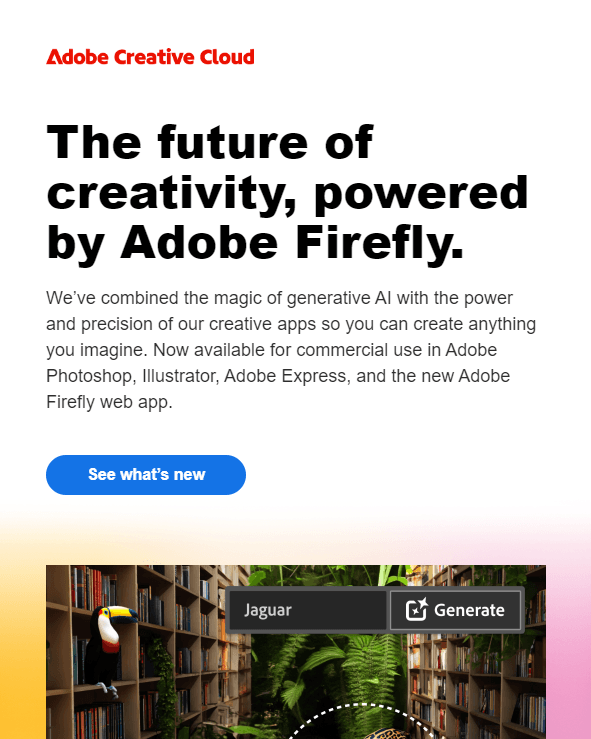
Adobe Creative Cloud
You've probably come across these emails; a brand you love or a software you frequently use pops into your inbox to announce new features or improvements.
They keep customers in the loop, letting them know that the brand is continuously evolving and improving for them. Nobody wants to be stuck with yesterday's tech or outdated fashion, right?
Introducing a new feature? Make sure to explain how it benefits the user. Remember, it's not just about what's new, but how the 'new' makes things better!
Here's how to make it work:
- Clear and Bright Imagery: Showcase the new updates visually. No one needs long texts.
- Concise Information: Don't overwhelm. Give clear explanations. If necessary, link to a more detailed blog or video tutorial.
- An Invitation to Engage: End with a call to action. Encourage users to try out the new feature or offer a webinar to deep dive into it.
11. New Content Announcement Emails
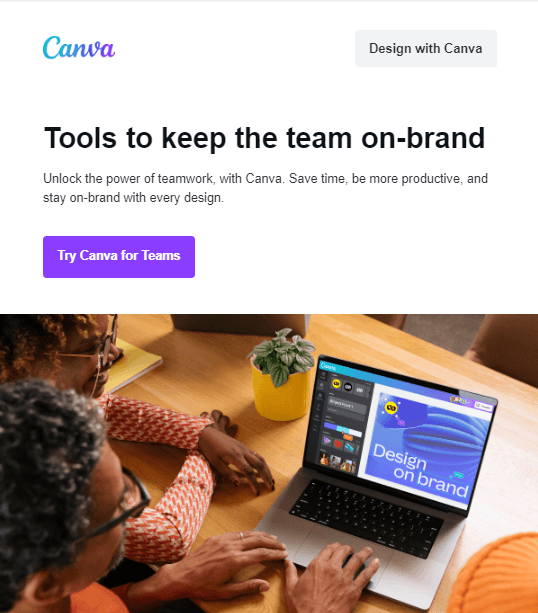
Canva
These emails serve as the grand curtains slowly being drawn, revealing a brand's latest masterpiece. It's a tease, an invitation, and a promise of something new, all wrapped into one.
By giving a sneak peek or heralding the arrival of a new product, brands build excitement. It's like the movie trailer before the blockbuster's release. Who doesn't love a good buildup?
For fans of the brand, these announcements act as reinforcement. "Look! Your favorite brand is at it again with something just for you!"
Offering subscribers an exclusive look or early-bird offer makes them feel special. And it feels good.
Some suggestions for you:
- Imagery: A picture is worth a thousand words. Showcase the new product in all its glory, making sure it's the star of the show.
- Intrigue with Copy: A little mystery never hurt anyone. Use compelling language to hint at the product's benefits without giving it all away.
- Clear Call to Action: Whether it's "Stay Tuned," "Pre-order Now," or "Discover More," guide the reader on their next steps.
12. Transactional Emails
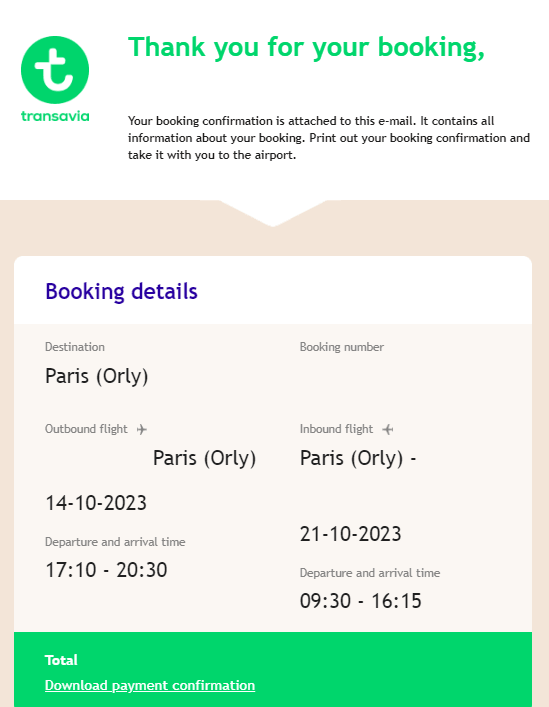
Transavia
These are emails that get triggered by a specific action you take, like making a purchase, signing up for an account, or resetting a password.
They're the pat on the back, the reassuring hand squeeze, letting you know, "Hey, we got this! Your order/action/request is in safe hands." Peace of mind? Priceless.
Whether it's tracking your package or guiding you through the next steps after registration, these emails equip you with what you need to know, when you need to know it.
These types of email campaigns are also a great way to sneak in a promotion or two (clever, right?).
Follow these steps to make the best out of it:
- Again, Personalize: A simple "Hi [Name]" goes a long way. It makes the email feel tailored just for your customer.
- Crystal Clear Information: Present the core information front and center, making it easy to spot.
- Consistent Branding: The email design and tone should be in sync with the brand's overall vibe. Yes, even transactional emails deserve to look good!
13. Thank You Emails 💌
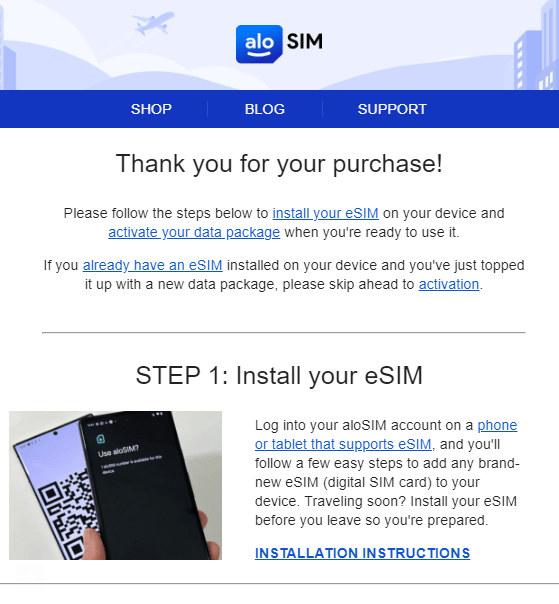
aloSIM
Now, if the Thank You Email were a person, it would be that delightful individual who remembers your birthday are showers you with surprise cupcakes. It's a digital hug.
A Thank You Email is a simple yet powerful gesture, letting customers know they're valued. By recognizing and appreciating the time, money, or effort someone has given, brands build a deeper connection with their audience.
It's subtle, but effective. A genuine thank you can encourage further interaction, be it another purchase or just sparking a conversation. And, after all, it just feels nice.
Besides making it personalized, here's what you can do:
Share a Story or Memory: Make it personal by recalling a specific interaction or sharing how their contribution made a difference. “Remember when you first joined our community back in January? Time flies, and we're so glad you're here!”
14. Confirmation Emails
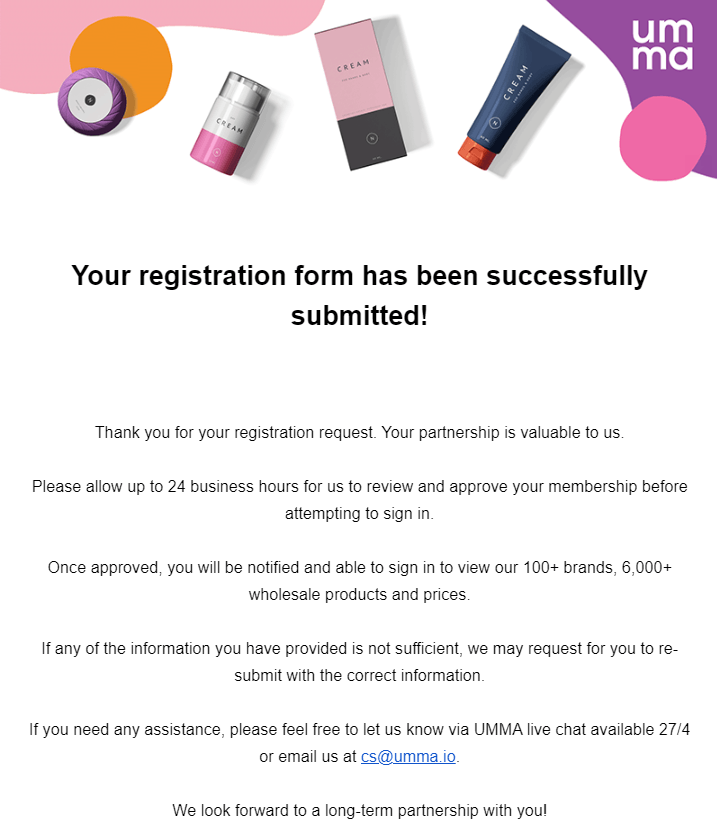
UMMA
It’s like a digital handshake or a virtual nod, letting you know "Message received, loud and clear!"
Ever ordered something and thought, "Did it go through? Did I just send my hard-earned cash into the digital abyss?" Confirmation emails are very reassuring, letting you know all is well in the world.
By instantly acknowledging an action, brands show they're on top of their game, building trust one confirmation at a time.
This might be a bold statement, but confirmation emails often boast higher open rates than other types of email marketing.
How to make it work better:
- Add a Dash of Personality: Who said confirmations have to be bland? Jazz it up with your brand's voice, be it witty, formal, or peppered with delightful emojis (responsibly, of course 😉).
- Serve Some Side Dishes: Alongside the main confirmation info, why not offer some related articles, products, or a little behind-the-scenes tidbit?
- Clear Call to Action: Need them to verify an account? Or perhaps download a ticket? Make the next step crystal clear and easy to spot
15. Sponsorship Emails
It’s when Brand A says, "Hey, we love Brand B and thought you might too!" It's not direct advertising, but more of a gentle nudge, a friendly recommendation.
Since the recommendation is coming from a trusted source (a brand or influencer you already admire), there's an immediate sense of credibility attached.
Instead of intrusive ads, you get a curated, personal introduction to something potentially wonderful.
Not every brand likes to toot its own horn. Sponsorship emails are one of email marketing campaign types that allow other brands to do the trumpeting on their behalf, in harmony and style.
Remember:
- Keep It Genuine: Only vouch for products or services that align with your brand and that you truly believe in. Authenticity is very important.
- Less is More: Instead of overwhelming your audience with information, pick one or two standout features and let them shine.
- Add a Personal Touch: Share a short story or a personal experience related to the product or service. Let your audience know why you love it.
16. Event Invitations
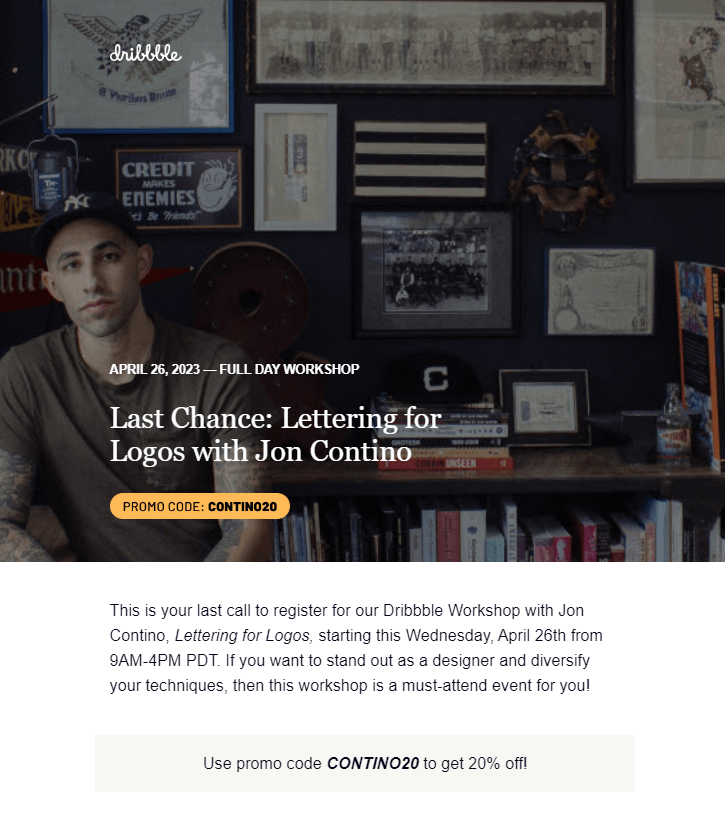
Dribble
Whether it's a corporate seminar, a charity gala, a product launch, or just your Aunt Muriel's yearly cat sweater party (no judgment, they’re surprisingly fun!), it’s this one among different types of emails that lets you in on the secret.
These emails are little suspense-packed parcels, creating a buzz and a sense of excitement. I mean, who isn't curious to know what's happening next Saturday night?
Location, time, date, dress code (important if it's a masquerade!), and everything else you need to know is all there. No more awkward, "Wait, was I supposed to bring a dish?" moments.
How to make it irresistible:
- Hook Them with the Headline: Your subject line should be the teaser trailer of your event. Make it attention-grabbing. Software for virtual events can easily help you with that.
- Visual Delight: Incorporate images or graphics that give a feel of the event. Think glitters for a gala, a sleek design for a corporate meet. or... anything.
- Clear Call-to-Action: Make the RSVP or any other desired action as obvious as a disco ball in a library. Big, shiny, and unmissable.
17. Internal Updates ⚙️
You've seen them among different types of emails, haven't you? Nestled among the discount codes and newsletters in your inbox is that subject line: "Company Update" or "Important Announcement".
From policy changes to exciting achievements, and from new hires to that much-awaited elevator repair status, this email genre has it covered. These emails ensure there are no 'I didn’t get the memo’ moments.
In a world full of whispers and hallway rumors, an Internal Updates Email is like a beacon of clarity. When the team knows the 'whats' and the 'whys' straight from the source, it fosters an environment of trust.
Make sure to follow these suggestions:
- Be Clear & Concise: G straight to the point. Use headings, bullet points, or even bold text to highlight crucial information.
- Human Touch: While you're being direct, don’t sound like a robot. A personal touch, maybe even a hint of humor or a light anecdote, can make your message resonate more.
- Consistency: Try to send them out at regular intervals – be it weekly or monthly. This way, your team will anticipate and even look forward to your updates.
18. Brand Story Emails
See those as a tale of a brand's journey, weaving its aspirations, trials, triumphs, and values into a captivating narrative.
What better way to connect than a story? By sharing your brand's journey, you're offering a transparent window into the soul of your company. The story's highs and lows allow readers to resonate with the brand on emotional level.
When you detail where you've been and where you're headed, you're outlining your brand identity. It can attract those who share the same values.
A brand story isn't just a narrative; it’s a testament to your authenticity. By showing vulnerability, passion, and dedication, you're making a silent pact with the reader, laying the foundation of trust and loyalty.
Some tips for you:
- Begin at the Beginning: Share what sparked the idea of your brand. Was it an ah-ha moment in the shower? Or perhaps a family legacy? The genuine start of your journey can be a relatable hook.
- Show, Don’t Just Tell: Use visuals to break up the text. Did you scribble your first logo on a napkin? Show them the napkin!
- Embrace Authenticity: This isn't the time for a sales pitch. Be honest about your successes and stumbles. Authenticity is the secret that'll have readers rooting for you.
At the end of the day, remember, you're not just sharing a story; you're building a legacy. So, put your heart into it. 💌
19. Review Request Emails
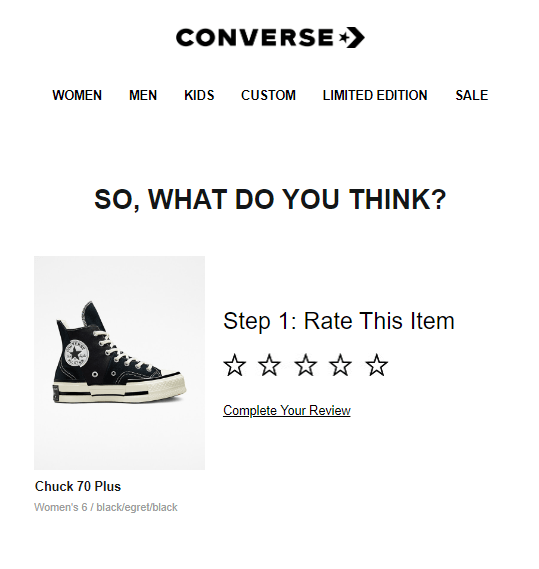
Converse
It's that little nudge from brands post-purchase, asking you to spare a few minutes and share your thoughts about their product or service.
Review requests are like holding a magnifying glass to your offerings. They help brands improve and adapt based on real user experiences.
Let's face it, we've all been there - scouring through reviews before committing to that purchase. Genuine customer reviews act as social proof, building trust and credibility for potential customers.
This way, brands continue the conversation with their customers. It’s a gentle reminder of the brand, fostering ongoing engagement.
And, of course, reviews can give a sweet boost to local SEO. More reviews often mean better visibility in search results.
Here come some trusty insights:
- Timing is Everything: Don’t wait for eons. The best time to request a review is shortly after the purchase when the experience is fresh in the customer's mind.
- Keep it Simple & Sweet: Avoid making your email a labyrinth. A straightforward request with a clear call-to-action is the way to go.
- Gratitude: Always express gratitude. A simple 'Thank You' can make the customer feel valued and more likely to respond.
- Provide an Easy Exit: Some customers might not be ready or willing. And that's okay! Always give them a hassle-free way to decline.
20. Onboarding Emails
Among different types of emails, this one is your guide when you're lost. It welcomes new users, customers, or subscribers, letting them know they're now part of something cool.
These emails guide users through the initial phases of a new product, service, or platform.
Onboarding emails set users up for success. Whether it's understanding the features of an app, the benefits of a subscription, or the perks of a new service – these emails ensure users get the most out of their choice.
By walking users step-by-step, answering potential questions, and highlighting value, onboarding emails foster a deeper connection between the brand and the user.
How to nail these email marketing campaign types?
- Keep the Flow: Start with a warm welcome, gradually introduce features, and wrap up with a compelling CTA.
- Segment & Personalize: Not every user is the same. Segment your audience and tailor your onboarding emails to match their needs and interests.
- Set Milestones & Celebrate: Break down the onboarding process into milestones. And when a user achieves one? Celebrate with them – it could be a simple congratulatory message or a badge.
🚀 Wrapping Up
If this whirlwind email tour has taught us anything, it's that there's an email for every occasion and a purpose behind every ping.
Your audience is out there, waiting, listening, and eager to engage. All they need is a nudge, a message, a connection.
